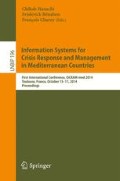Abstract
Current technological advances on ubiquitous computing and web 2.0 open up new possibilities to promote an active participation of citizens in different domains including emergency management. Such a kind of participative model requires not a proactive attitude from citizens but also of the implication of emergency management organizations that have the responsibility of managing the situation. Emergency management is a highly professional domain characterized by the stress that emergency workers experience when facing unpredictable events that have a social and economic impact in society. Citizens could contribute in this process as far as they do not interfere with the protocols and activities of professional workers who will not accept any change that could compromise their efficacy. Many research works focus on how citizens utilize social technologies during emergency situations for self-organizing or for citizen journalism, however, the perspective of emergency management organization has been less explored. In this paper, we present a study that goes deeper into how organizations envision the use of technologies to increase citizen participation in their procedures. This study aims at being a step further to understand how a more active and effective citizen role could be reached and how technologies could contribute to this end.
Access this chapter
Tax calculation will be finalised at checkout
Purchases are for personal use only
Preview
Unable to display preview. Download preview PDF.
References
Palen, L., Anderson, K.M., Mark, G., Martin, J., Sicker, D., Palmer, M., Grunwald, D.: A vision for technology-mediated support for public participation and assistance in mass emergencies and disasters. In: Proceedings of the 2010 ACM-BCS Visions of Computer Science Conference (ACM-BCS 2010), British Computer Society, Swinton (2010)
Taylor, M.: Community Participation in the Real World: Opportunities and Pitfalls in New Governance Spaces. Urban Studies 44(2), 297–317 (2007)
Arnstein, S.R.: A Ladder of Citizen Participation. JAIP 35(4), 216–224 (1969)
Shklovski, I., Burke, M., Kiesler, S., Kraut, R.: Use of Communication Technologies in Hurricane Katrina Aftermath. Position paper for the HCI for Emergencies Workshop at SIGCHI 2008 (2008)
Sutton, J., Palen, L., Shklovski, I.: Backchannels on the front lines: Emergent uses of social media in the 2007 southern California wildfires. In: Proc. Information Systems for Crisis Response and Management Conference, ISCRAM (May 2008)
Miyabe, M., Miura, A., Aramaki, E.: Use trend analysis of twitter after the great east Japan earthquake. In: Proc. ACM Conference on Computer Supported Cooperative Work Companion (February 2012)
Yates, D., Wagner, C., Majchrzak, A.: Factors affecting shapers of organizational wikis. Journal of the American Society for Information Science and Technology 61(3), 543–554 (2010)
Schuler, D.: Social computing. Communications of the ACM (1994)
Reuter, C., Marx, A., Pipek, V.: Social Software as an Infrastructure for Crisis Management: A case study about current practice and potential usage. In: 8th international conference on Information Systems for Crisis Response and Management (ISCRAM 2011), Lisbon, Portugal (May 2011)
White, C.M.: Social Media, Crisis, Communication, and Emergency Management: Leveraging Web 2.0 Technologies. CRC Press (2007)
Fox, Z.: Red Cross launches social media disaster response center. Mashable, http://mashable.com/2012/03/07/red-cross-digital-operations-center/ (accessed May 10, 2014)
White, C., Plotnick, L., Kushma, J., Hiltz, S.R., Turoff, M.: An Online Social Network for Emergency Management. In: Proc. Information Systems for Crisis Response and Management Conference, ISCRAM (May 2009)
Hagar, C.: Crisis Informatics: Perspectives of Trust–Is Social Media a Mixed Blessing? SLIS Student Research Journal 2, 2 (2013)
Crowe, A.: Disasters 2.0: The application of social media systems for modern emergency management. CRC Press (2012)
Oxley, A.: Security Risks in Social Media Technologies: Safe practices in public service applications. Elsevier (2013)
Ericsson, K.A., Simon, H.A.: Protocol analysis. MIT press (1985)
Oulahen, G.S.: Citizen participation in post-disaster flood hazard mitigation planning: Exploring strategic choices in Peterborough, Ontario (2008)
Cheong, F., Cheong, C.: Social Media Data Mining: A Social Network Analysis Of Tweets During The 2010-2011 Australian Floods. In: PACIS (2011)
Caverlee, J., Liu, L., Webb, S.: Socialtrust: tamper-resilient trust establishment in online communities. In: Proceedings of the 8th ACM/IEEE-CS Joint Conference on Digital Libraries, pp. 104–114. ACM (2008)
Goodchild, M.F.: Citizens as sensors: the world of volunteered geography. GeoJournal 69(4), 211–221 (2007)
Florin, P., Wandersman, A.: An introduction to citizen participation, voluntary organizations, and community development: Insights for empowerment through research. American Journal of Community Psychology 18(1), 41–54 (1990)
Kongthon, A., Haruechaiyasak, C., Pailai, J., Kongyoung, S.: The role of Twitter during a natural disaster: Case study of 2011 Thai Flood. In: 2012 Proceedings of PICMET 2012 Technology Management for Emerging Technologies (PICMET), pp. 2227–2232. IEEE (2012)
Fischer, G., Piccino, A., Ye, Y.: The ecology of participants in co-evolving socio-technical environments. Engineering Interactive Systems, pp. 279–286. Springer, Heidelberg (2008)
Díaz, P., Aedo, I., Romano, M., Onorati, T.: Supporting Citizens 2.0 in Disasters Response. In: Proceeding of: MeTTeG 2013: Conference on Methodologies, Technologies and Tools enabling e-Government (2013)
Author information
Authors and Affiliations
Editor information
Editors and Affiliations
Rights and permissions
Copyright information
© 2014 Springer International Publishing Switzerland
About this paper
Cite this paper
Díaz, P., Aedo, I., Herranz, S. (2014). Citizen Participation and Social Technologies: Exploring the Perspective of Emergency Organizations. In: Hanachi, C., Bénaben, F., Charoy, F. (eds) Information Systems for Crisis Response and Management in Mediterranean Countries. ISCRAM-med 2014. Lecture Notes in Business Information Processing, vol 196. Springer, Cham. https://doi.org/10.1007/978-3-319-11818-5_8
Download citation
DOI: https://doi.org/10.1007/978-3-319-11818-5_8
Publisher Name: Springer, Cham
Print ISBN: 978-3-319-11817-8
Online ISBN: 978-3-319-11818-5
eBook Packages: Computer ScienceComputer Science (R0)

